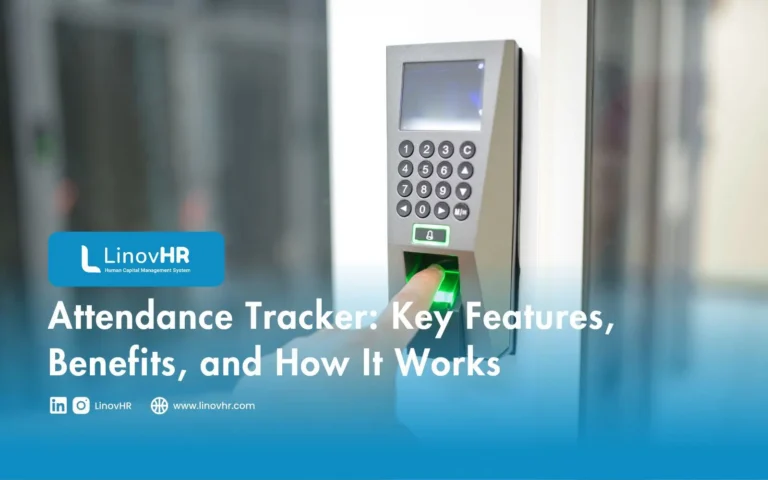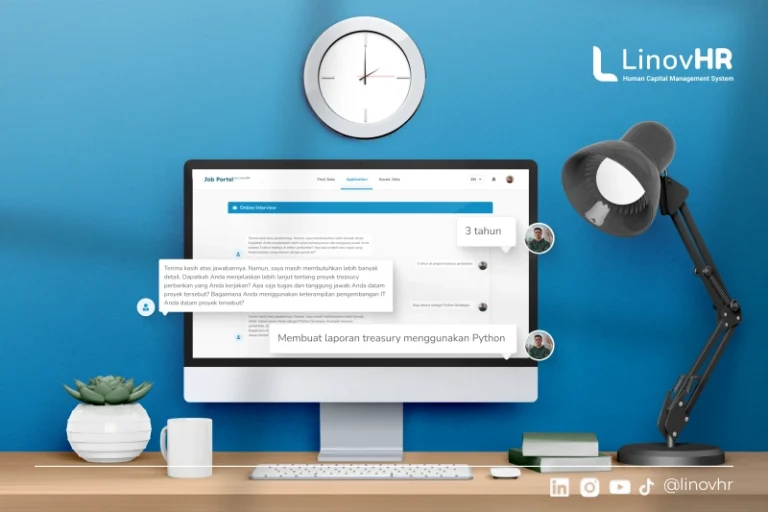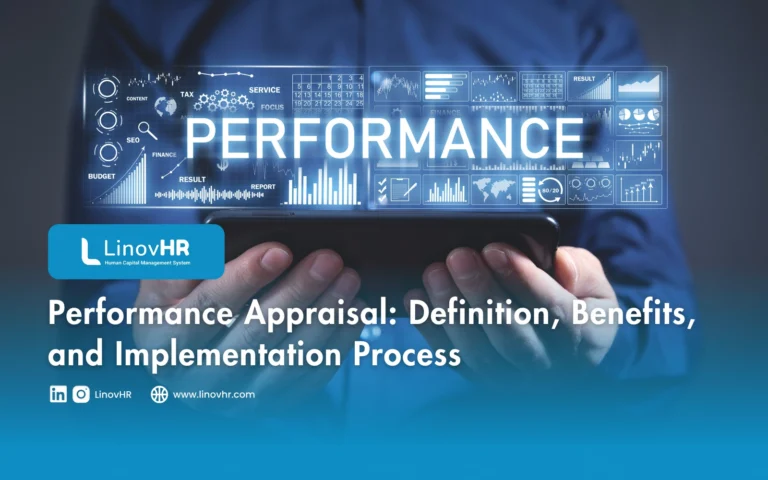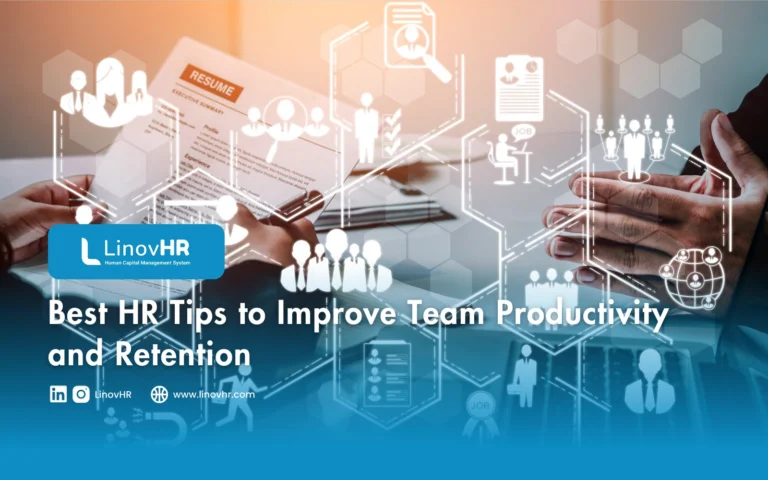Managing employee attendance today is more than just tracking presence, it’s about ensuring productivity, compliance, and fair compensation.
With remote and hybrid setups becoming the norm, companies need a smart system that records time accurately and transparently.
An advanced attendance tracker provides real-time visibility, reduces administrative workload, and helps HR make better workforce decisions.
In this article, we’ll explore why attendance tracking is crucial for modern businesses, the key features to look for, and how a digital solution like LinovHR can streamline the entire process.
What Is an Attendance Tracker?
An attendance tracker is a tool used to monitor when employees start and end their workday, whether they are present, absent, late, or on leave.
In the past, attendance was tracked using paper forms or punch cards. Today, most organizations rely on digital systems that automate the entire process.
A modern attendance tracker helps businesses accurately record working hours, support payroll calculations, and manage leave more efficiently.
By reducing manual work and minimizing human error, it enables HR teams to focus more on strategic tasks and ensure fair, transparent workforce management.
Types of Attendance Trackers
Attendance tracking systems come in multiple formats to support different work environments and operational needs. Here are the most common types:
1. Software and Web-Based Systems
These cloud-driven platforms allow HR teams to manage attendance centrally through a browser or desktop application. They offer automation, real-time visibility, and seamless integration with payroll systems.
2. Mobile Attendance Apps
Ideal for remote workers, field teams, or flexible workplaces, mobile apps enable employees to clock in from anywhere using their smartphones, often with GPS validation.
3. Biometric Attendance Systems
Using unique identifiers like fingerprints or facial recognition, biometric devices deliver high accuracy and reduce risks of buddy punching or fraud.
4. Card-Based Time Tracking
Employees use magnetic stripe or RFID cards to clock in and out through scanning terminals. This method is simple and widely used in factories, offices, and retail.
5. Spreadsheet-Based Trackers
Tools like Excel or Google Sheets allow basic attendance monitoring at a low cost. This method fits very small teams but requires manual updates and offers limited automation.
Why Attendance Tracking Matters for Businesses Today
Modern organizations operate in fast-moving environments where employee productivity, compliance, and operational efficiency are crucial.
An accurate and reliable attendance tracking system plays a key role in supporting these needs.
Here are the top reasons attendance tracking is essential for businesses today:
1. Ensures Accurate Payroll and Leave Management
Automated attendance systems significantly reduce human errors that often occur with manual data entry. This ensures employees are paid fairly and accurately based on their actual working hours, including overtime.
It also simplifies leave tracking, preventing disputes and improving trust between employees and HR.
2. Boosts Productivity and Efficiency
By eliminating time-consuming administrative tasks, HR teams and managers can focus more on strategic work like performance improvement and workforce planning.
Employees also spend less time dealing with manual attendance forms or correction requests. Over time, this leads to more efficient operations and better resource allocation.
3. Strengthens Compliance with Labor Regulations
Attendance tracking systems help organizations stay compliant with legal requirements related to working hours, break rules, and overtime.
They automatically record necessary data for audits and inspections, reducing the risk of fines or legal issues.
Compliance features also give businesses peace of mind when managing a large or distributed workforce.
4. Reduces Absenteeism and Improves Accountability
With transparent and monitored attendance records, employees become more accountable for their work habits. This visibility helps reduce late arrivals, unexcused absences, and “buddy punching.”
As attendance data becomes more accurate, managers can act quickly to address patterns of absenteeism.
5. Enables Smarter Workforce Decisions with Real-Time Data
Reliable attendance data helps leaders analyze trends such as high overtime, frequent tardiness, or specific departmental issues.
With these insights, companies can identify root causes and take proactive actions like scheduling adjustments or employee support programs.
Data-driven decisions lead to better workforce planning and improved overall performance.
6. Builds Trust by Empowering Employees
When employees can access their attendance records, leave balances, and overtime information at any time, they feel more in control of their work schedule.
This transparency reduces the need to contact HR for small requests and helps avoid misunderstandings.
As a result, it contributes to a more positive and trustworthy work environment.
Key Features of an Attendance Tracker
A modern attendance tracker comes with a variety of tools designed to make workforce management more efficient. Here are the essential features to look for:
1. Real-Time Attendance Monitoring
HR and managers can instantly view employee check-ins, check-outs, and current work status. This improves visibility across different teams or locations, especially for hybrid and field workers.
With timely data, issues like absenteeism or unexpected schedule changes can be addressed quickly.
2. Biometric or Digital Verification
Modern attendance trackers support secure verification methods such as facial recognition, fingerprints, or mobile app check-ins. This reduces buddy punching and time fraud, ensuring data accuracy.
It also provides a seamless and fast experience for employees.
3. Automated Shift Scheduling
The system helps HR assign, adjust, and track shifts more efficiently without relying on manual spreadsheets. Employees are notified instantly about schedule updates, preventing miscommunication.
It supports multiple work patterns including rotating shifts, split shifts, and overtime rules.
4. Leave and Overtime Tracking
Attendance trackers automatically calculate late arrivals, absences, and overtime contributions. Employees can request time off within the platform, and managers can approve with just a click.
This helps organizations maintain compliance with labor regulations while reducing administrative workload.
5. Integration With Payroll Systems
Attendance data is connected directly to payroll to eliminate manual input and avoid salary calculation errors. Payments for overtime, shift premiums, and allowances are calculated automatically.
As a result, payroll processing becomes faster, more transparent, and more accurate.
6. Attendance Analytics and Reporting
HR can generate insights into attendance patterns, productivity, and workforce discipline. These analytics help identify trends like high absenteeism or late arrivals in specific departments.
With data-driven decision-making, companies can improve efficiency and better support employee performance.
How to Choose the Right Attendance Tracker
Choosing the right attendance tracker is not just about selecting the cheapest option or the one with the longest feature list.
It requires evaluating whether the solution truly fits the way your business operates and solves your biggest attendance challenges.
1. Understand Your Workforce Needs
Start by defining what your organization actually requires. Consider the size of your team and whether your business is growing, as smaller companies typically need simpler systems while larger enterprises demand more robust and scalable solutions.
Your workforce model also plays a major role. On-site employees may benefit from biometric time clocks or shared kiosk devices, while remote or field-based workers need a cloud solution that supports mobile clock-ins and GPS verification.
Additionally, different industries may require specific features, like shift scheduling in hospitality or integration with project tracking tools in corporate offices.
Most importantly, define the core problem you want to fix, whether it’s payroll inaccuracies, buddy punching, complicated leave requests, or time-consuming manual work. This will determine which features are essential.
2. Prioritize the Features That Matter Most
Once your needs are clear, separate the must-have features from the nice-to-haves. Essential capabilities often include flexible clock-in/out methods, payroll integration, and centralized leave management. These features ensure efficiency and accuracy from day one.
Additional features, such as employee self-service, automated compliance rules, or real-time attendance alerts, can enhance the system further, but shouldn’t inflate your budget if they aren’t mission-critical.
Setting clear priorities helps avoid paying for tools your workforce won’t use.
3. Check System Compatibility and Ease of Use
An attendance tracker must align with the technology your organization already relies on. Check if it integrates seamlessly with your existing HRIS, payroll, ERP, or scheduling tools.
Ease of use is equally important, if the system is too complex, adoption will drop, leading to more errors and frustration. Look for a clean, intuitive interface and simple workflows.
Also consider deployment options: cloud-based systems offer accessibility and minimal IT maintenance, while on-premise solutions provide greater control but require internal support.
4. Evaluate Vendor Reliability, Cost, and Support
Before choosing a provider, take the time to review pricing structures in detail. Some vendors charge extra for set-up, training, or customer support. Subscription tiers should be flexible enough to scale with your business as it grows.
Always test the system through a free trial or demo to see how it performs in real usage. And make sure support channels, such as chat, phone, or email, are responsive, especially for issues that can delay payroll or compliance.
How LinovHR Makes Attendance Tracking Easier for Businesses
Managing employee attendance in fast moving work environments can be challenging, especially for organizations with shift rotations, hybrid workers, or field teams.
LinovHR’s Time Management module provides a complete and modern attendance tracking solution tailored to the needs of Indonesian businesses.
With automated scheduling, real-time monitoring, and seamless integration with payroll, LinovHR removes manual administrative work and strengthens discipline and productivity across the workforce.
Employees can clock in and access their schedules directly from a mobile app, while HR teams gain accurate data insight through a centralized dashboard.
LinovHR supports every aspect of attendance tracking, including:
- Flexible Shift Scheduling: Create and adjust work shifts easily to meet dynamic operational needs.
- Accurate Time & Attendance Recording: Automatic clock-in/clock-out and late tolerance settings improve punctuality and compliance.
- Overtime Management: Automate overtime requests and calculations to ensure fair and accurate compensation.
- Leave & Permission Requests: Manage approval workflows for leave and urgent absences in one system.
- Timesheet & Payroll Integration: Generate detailed attendance records that sync directly into payroll.
- Mobile Attendance: Enable employees to mark attendance anywhere using their smartphones.
With advanced workforce analytics, HR can track absenteeism trends, identify attendance issues earlier, and make strategic decisions based on reliable data.
From preventing buddy punching to simplifying shift swaps between employees, LinovHR ensures efficient, transparent, and error-free attendance management.
In short, LinovHR isn’t just an attendance system, it’s a smart, cloud-based workforce solution that empowers companies to improve discipline, increase operational efficiency, and support a productive working culture.
Ready to modernize your attendance tracking? Request a free demo with LinovHR today.







